Professional Practice in Accounting: Career Planning Report
VerifiedAdded on 2020/03/04
|19
|4089
|367
Report
AI Summary
This report delves into career planning within the accounting field, specifically targeting the role of a Senior Business Analyst in the aviation industry, using Qantas as a case study. The report details the nature of the work, including responsibilities such as financial modeling, data analysis, and reporting on performance metrics. It outlines the required education, skills, and personality traits for success, alongside salary expectations and the labor market outlook. Furthermore, the report examines the employer, Qantas, including its organizational structure, culture, and opportunities for promotion. It also explores typical career paths, from entry-level positions to senior management, and reflects on the author's personal fit within the field, drawing connections to their interests, skills, and values. The analysis includes salary ranges, job market trends, and potential career advancement opportunities within the organization and the broader industry. This report is a valuable resource for students seeking career guidance in accounting and related fields.

Professional practice in accounting
Paraphrase This Document
Need a fresh take? Get an instant paraphrase of this document with our AI Paraphraser
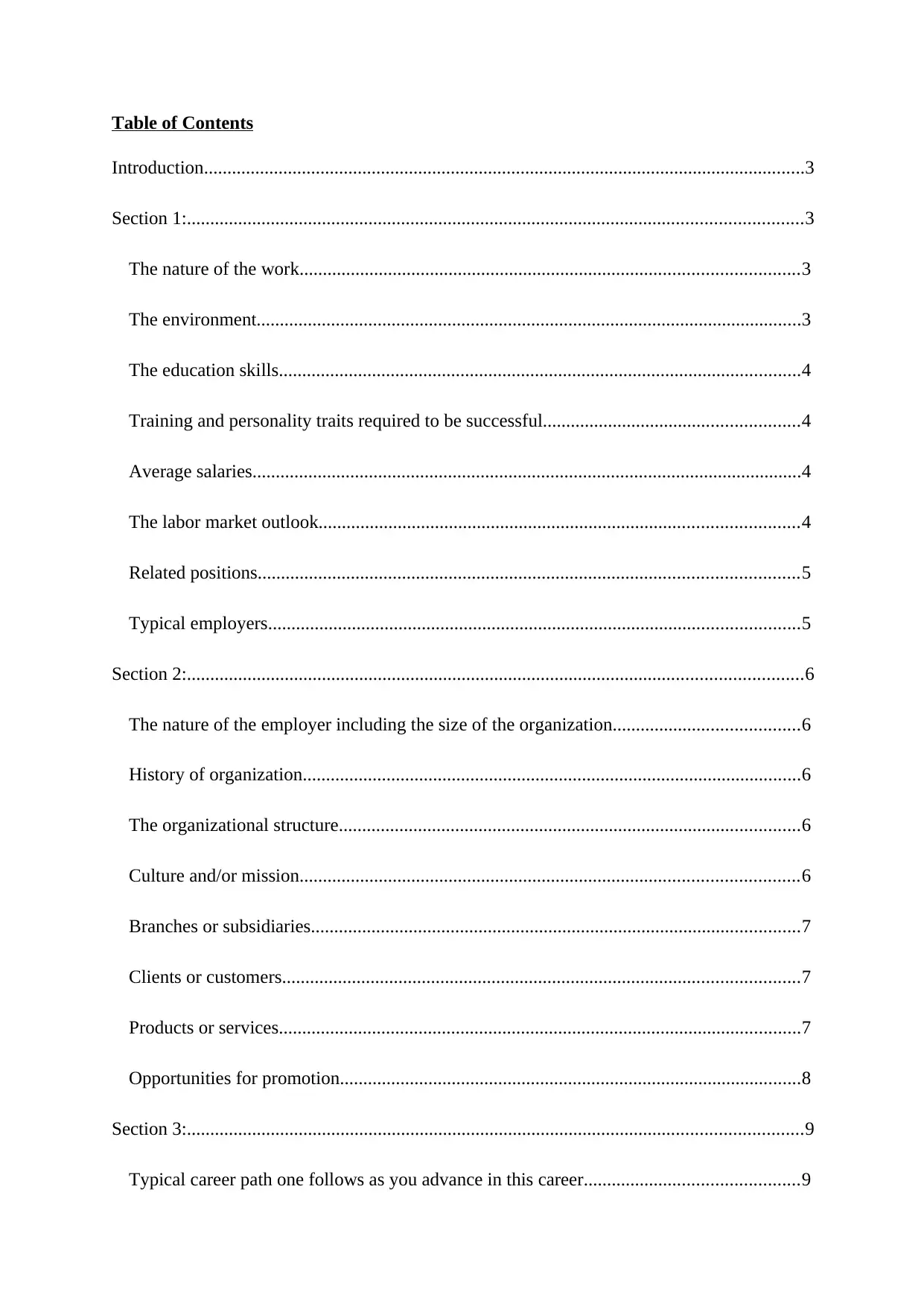
Table of Contents
Introduction.................................................................................................................................3
Section 1:....................................................................................................................................3
The nature of the work...........................................................................................................3
The environment.....................................................................................................................3
The education skills................................................................................................................4
Training and personality traits required to be successful.......................................................4
Average salaries......................................................................................................................4
The labor market outlook.......................................................................................................4
Related positions....................................................................................................................5
Typical employers..................................................................................................................5
Section 2:....................................................................................................................................6
The nature of the employer including the size of the organization........................................6
History of organization...........................................................................................................6
The organizational structure...................................................................................................6
Culture and/or mission...........................................................................................................6
Branches or subsidiaries.........................................................................................................7
Clients or customers...............................................................................................................7
Products or services................................................................................................................7
Opportunities for promotion...................................................................................................8
Section 3:....................................................................................................................................9
Typical career path one follows as you advance in this career..............................................9
Introduction.................................................................................................................................3
Section 1:....................................................................................................................................3
The nature of the work...........................................................................................................3
The environment.....................................................................................................................3
The education skills................................................................................................................4
Training and personality traits required to be successful.......................................................4
Average salaries......................................................................................................................4
The labor market outlook.......................................................................................................4
Related positions....................................................................................................................5
Typical employers..................................................................................................................5
Section 2:....................................................................................................................................6
The nature of the employer including the size of the organization........................................6
History of organization...........................................................................................................6
The organizational structure...................................................................................................6
Culture and/or mission...........................................................................................................6
Branches or subsidiaries.........................................................................................................7
Clients or customers...............................................................................................................7
Products or services................................................................................................................7
Opportunities for promotion...................................................................................................8
Section 3:....................................................................................................................................9
Typical career path one follows as you advance in this career..............................................9
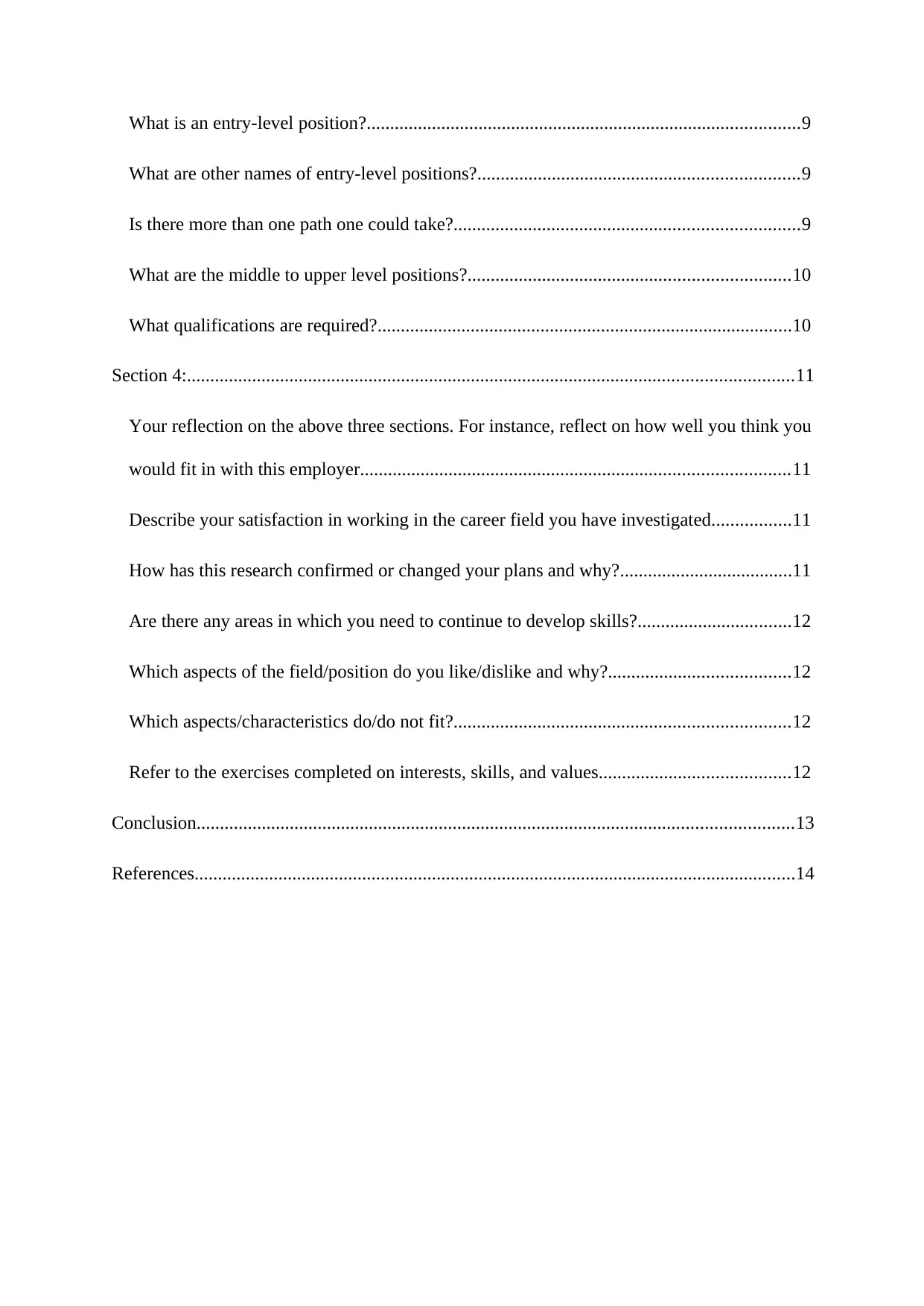
What is an entry-level position?.............................................................................................9
What are other names of entry-level positions?.....................................................................9
Is there more than one path one could take?..........................................................................9
What are the middle to upper level positions?.....................................................................10
What qualifications are required?.........................................................................................10
Section 4:..................................................................................................................................11
Your reflection on the above three sections. For instance, reflect on how well you think you
would fit in with this employer............................................................................................11
Describe your satisfaction in working in the career field you have investigated.................11
How has this research confirmed or changed your plans and why?.....................................11
Are there any areas in which you need to continue to develop skills?.................................12
Which aspects of the field/position do you like/dislike and why?.......................................12
Which aspects/characteristics do/do not fit?........................................................................12
Refer to the exercises completed on interests, skills, and values.........................................12
Conclusion................................................................................................................................13
References.................................................................................................................................14
What are other names of entry-level positions?.....................................................................9
Is there more than one path one could take?..........................................................................9
What are the middle to upper level positions?.....................................................................10
What qualifications are required?.........................................................................................10
Section 4:..................................................................................................................................11
Your reflection on the above three sections. For instance, reflect on how well you think you
would fit in with this employer............................................................................................11
Describe your satisfaction in working in the career field you have investigated.................11
How has this research confirmed or changed your plans and why?.....................................11
Are there any areas in which you need to continue to develop skills?.................................12
Which aspects of the field/position do you like/dislike and why?.......................................12
Which aspects/characteristics do/do not fit?........................................................................12
Refer to the exercises completed on interests, skills, and values.........................................12
Conclusion................................................................................................................................13
References.................................................................................................................................14
⊘ This is a preview!⊘
Do you want full access?
Subscribe today to unlock all pages.

Trusted by 1+ million students worldwide
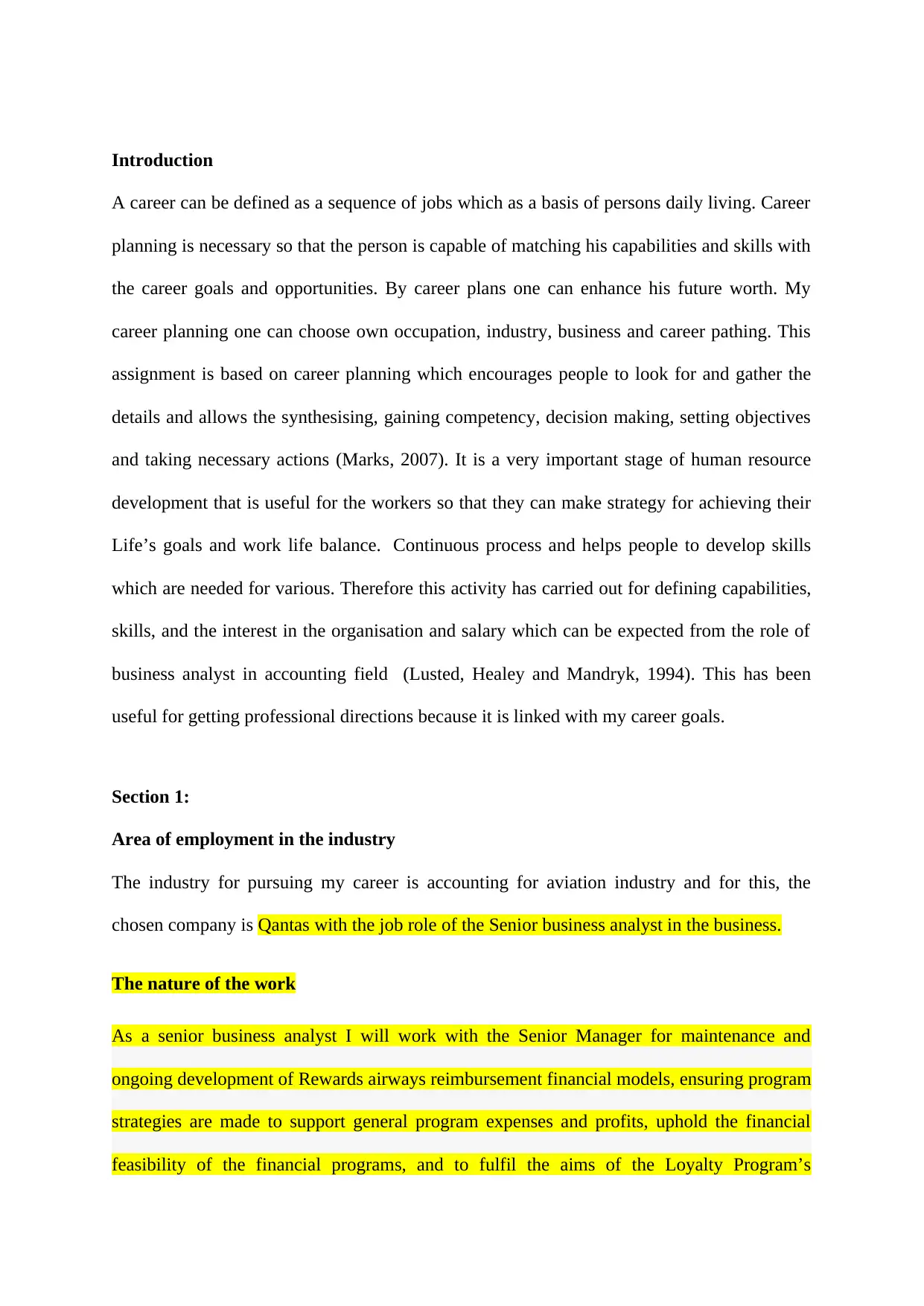
Introduction
A career can be defined as a sequence of jobs which as a basis of persons daily living. Career
planning is necessary so that the person is capable of matching his capabilities and skills with
the career goals and opportunities. By career plans one can enhance his future worth. My
career planning one can choose own occupation, industry, business and career pathing. This
assignment is based on career planning which encourages people to look for and gather the
details and allows the synthesising, gaining competency, decision making, setting objectives
and taking necessary actions (Marks, 2007). It is a very important stage of human resource
development that is useful for the workers so that they can make strategy for achieving their
Life’s goals and work life balance. Continuous process and helps people to develop skills
which are needed for various. Therefore this activity has carried out for defining capabilities,
skills, and the interest in the organisation and salary which can be expected from the role of
business analyst in accounting field (Lusted, Healey and Mandryk, 1994). This has been
useful for getting professional directions because it is linked with my career goals.
Section 1:
Area of employment in the industry
The industry for pursuing my career is accounting for aviation industry and for this, the
chosen company is Qantas with the job role of the Senior business analyst in the business.
The nature of the work
As a senior business analyst I will work with the Senior Manager for maintenance and
ongoing development of Rewards airways reimbursement financial models, ensuring program
strategies are made to support general program expenses and profits, uphold the financial
feasibility of the financial programs, and to fulfil the aims of the Loyalty Program’s
A career can be defined as a sequence of jobs which as a basis of persons daily living. Career
planning is necessary so that the person is capable of matching his capabilities and skills with
the career goals and opportunities. By career plans one can enhance his future worth. My
career planning one can choose own occupation, industry, business and career pathing. This
assignment is based on career planning which encourages people to look for and gather the
details and allows the synthesising, gaining competency, decision making, setting objectives
and taking necessary actions (Marks, 2007). It is a very important stage of human resource
development that is useful for the workers so that they can make strategy for achieving their
Life’s goals and work life balance. Continuous process and helps people to develop skills
which are needed for various. Therefore this activity has carried out for defining capabilities,
skills, and the interest in the organisation and salary which can be expected from the role of
business analyst in accounting field (Lusted, Healey and Mandryk, 1994). This has been
useful for getting professional directions because it is linked with my career goals.
Section 1:
Area of employment in the industry
The industry for pursuing my career is accounting for aviation industry and for this, the
chosen company is Qantas with the job role of the Senior business analyst in the business.
The nature of the work
As a senior business analyst I will work with the Senior Manager for maintenance and
ongoing development of Rewards airways reimbursement financial models, ensuring program
strategies are made to support general program expenses and profits, uphold the financial
feasibility of the financial programs, and to fulfil the aims of the Loyalty Program’s
Paraphrase This Document
Need a fresh take? Get an instant paraphrase of this document with our AI Paraphraser

leadership team. I will also have to connect to the leadership and the Rewards business team
to build up, document, and apply strategies as essential to deal with the airline’s issues This
role will be reporting to the Head of Ground Services, the Senior Business Analyst is
accountable for following, examining and reporting efficiency and service linked
performance methods to support business judgments. A few of the key job of the role are
(however not restricted to)
give logical support to the Ground Services business by the expansion of business cases,
financial modeling and data analysis to support business decision making;
Record and report advancement on operations major performance signs all over the
Ground Services company
Provide reports and breakdown on SLA performance and operational key performance
indicators to inner and exterior stakeholders (Seek.com.au).
Lead and support by project management, investigation and process development
appraisals, Ground Services progress initiatives;
The environment
The accounting personal has to work in the sustainable environmental and has to deal with
various International, national and local environmental challenges (Qantas.com, 2017). There
are six areas to be focused by the senior accounts professional at Qantas which include the
aircrafts, fuel-efficiency, in flight programmes and sustainable products.
The education skills
For becoming a senior business analyst, the main educational skills that would be required
are - CA or CPA. This position will need strong technical capabilities and experiences along
with demonstration of people skills and professional efficiency.
to build up, document, and apply strategies as essential to deal with the airline’s issues This
role will be reporting to the Head of Ground Services, the Senior Business Analyst is
accountable for following, examining and reporting efficiency and service linked
performance methods to support business judgments. A few of the key job of the role are
(however not restricted to)
give logical support to the Ground Services business by the expansion of business cases,
financial modeling and data analysis to support business decision making;
Record and report advancement on operations major performance signs all over the
Ground Services company
Provide reports and breakdown on SLA performance and operational key performance
indicators to inner and exterior stakeholders (Seek.com.au).
Lead and support by project management, investigation and process development
appraisals, Ground Services progress initiatives;
The environment
The accounting personal has to work in the sustainable environmental and has to deal with
various International, national and local environmental challenges (Qantas.com, 2017). There
are six areas to be focused by the senior accounts professional at Qantas which include the
aircrafts, fuel-efficiency, in flight programmes and sustainable products.
The education skills
For becoming a senior business analyst, the main educational skills that would be required
are - CA or CPA. This position will need strong technical capabilities and experiences along
with demonstration of people skills and professional efficiency.
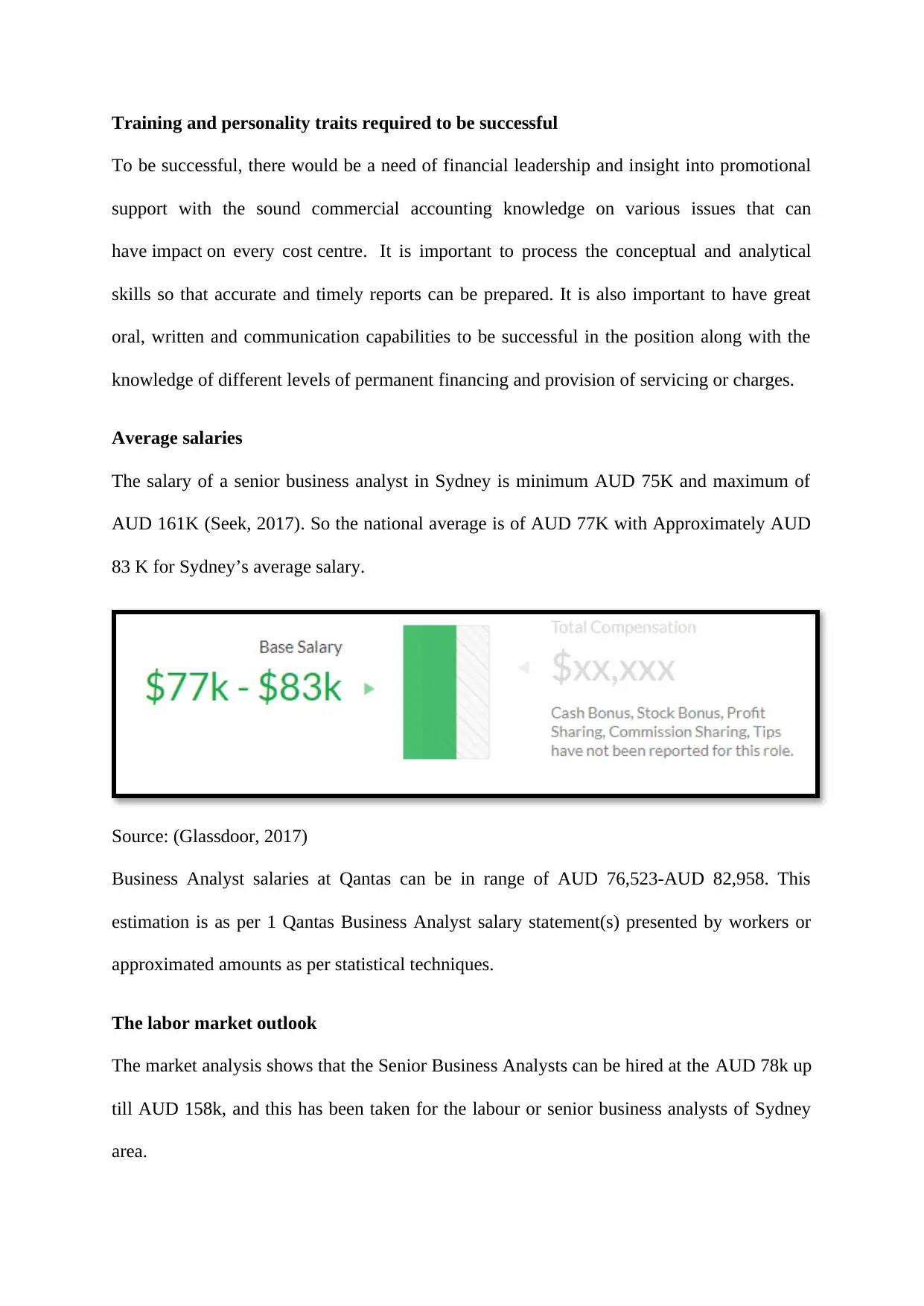
Training and personality traits required to be successful
To be successful, there would be a need of financial leadership and insight into promotional
support with the sound commercial accounting knowledge on various issues that can
have impact on every cost centre. It is important to process the conceptual and analytical
skills so that accurate and timely reports can be prepared. It is also important to have great
oral, written and communication capabilities to be successful in the position along with the
knowledge of different levels of permanent financing and provision of servicing or charges.
Average salaries
The salary of a senior business analyst in Sydney is minimum AUD 75K and maximum of
AUD 161K (Seek, 2017). So the national average is of AUD 77K with Approximately AUD
83 K for Sydney’s average salary.
Source: (Glassdoor, 2017)
Business Analyst salaries at Qantas can be in range of AUD 76,523-AUD 82,958. This
estimation is as per 1 Qantas Business Analyst salary statement(s) presented by workers or
approximated amounts as per statistical techniques.
The labor market outlook
The market analysis shows that the Senior Business Analysts can be hired at the AUD 78k up
till AUD 158k, and this has been taken for the labour or senior business analysts of Sydney
area.
To be successful, there would be a need of financial leadership and insight into promotional
support with the sound commercial accounting knowledge on various issues that can
have impact on every cost centre. It is important to process the conceptual and analytical
skills so that accurate and timely reports can be prepared. It is also important to have great
oral, written and communication capabilities to be successful in the position along with the
knowledge of different levels of permanent financing and provision of servicing or charges.
Average salaries
The salary of a senior business analyst in Sydney is minimum AUD 75K and maximum of
AUD 161K (Seek, 2017). So the national average is of AUD 77K with Approximately AUD
83 K for Sydney’s average salary.
Source: (Glassdoor, 2017)
Business Analyst salaries at Qantas can be in range of AUD 76,523-AUD 82,958. This
estimation is as per 1 Qantas Business Analyst salary statement(s) presented by workers or
approximated amounts as per statistical techniques.
The labor market outlook
The market analysis shows that the Senior Business Analysts can be hired at the AUD 78k up
till AUD 158k, and this has been taken for the labour or senior business analysts of Sydney
area.
⊘ This is a preview!⊘
Do you want full access?
Subscribe today to unlock all pages.

Trusted by 1+ million students worldwide
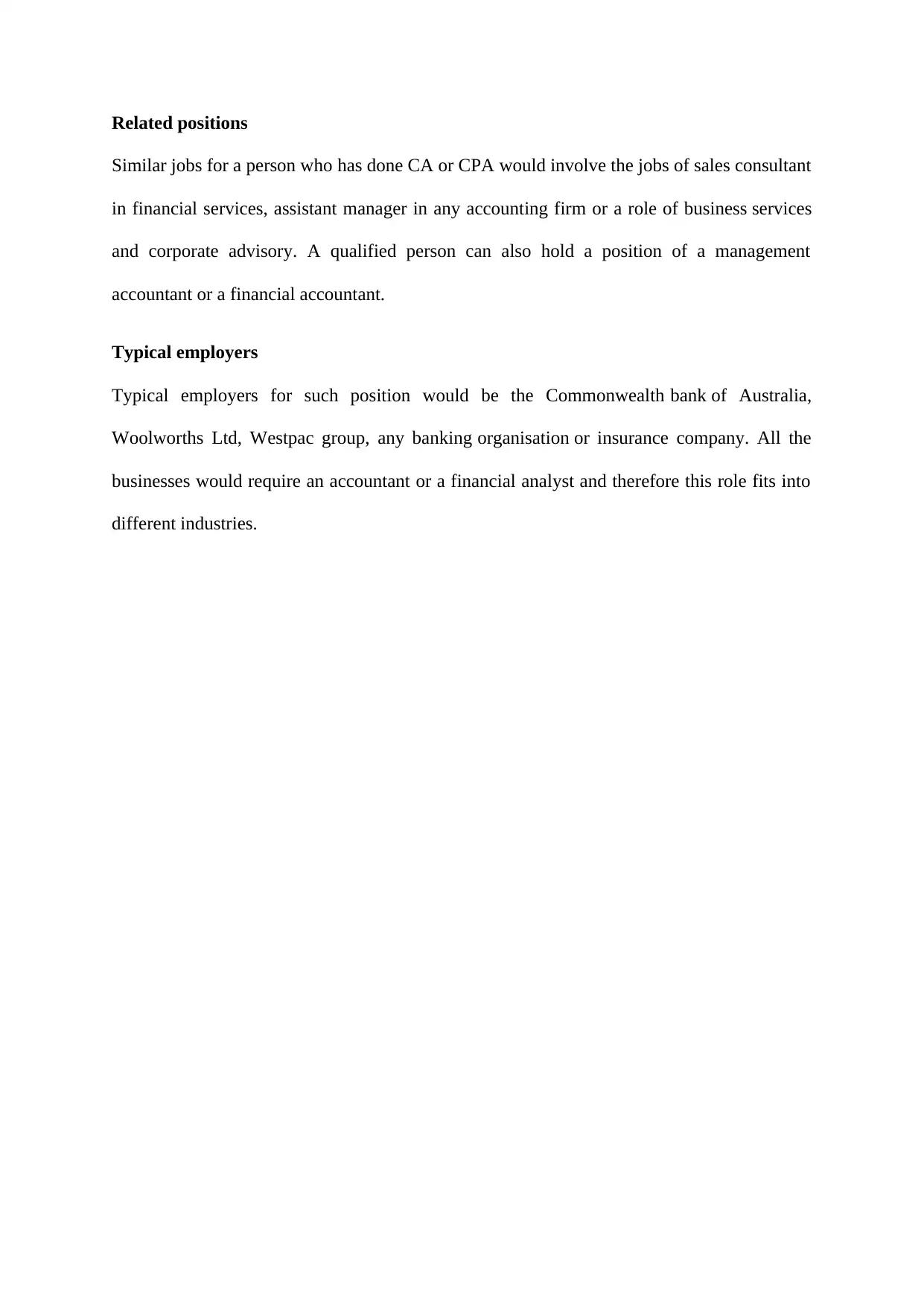
Related positions
Similar jobs for a person who has done CA or CPA would involve the jobs of sales consultant
in financial services, assistant manager in any accounting firm or a role of business services
and corporate advisory. A qualified person can also hold a position of a management
accountant or a financial accountant.
Typical employers
Typical employers for such position would be the Commonwealth bank of Australia,
Woolworths Ltd, Westpac group, any banking organisation or insurance company. All the
businesses would require an accountant or a financial analyst and therefore this role fits into
different industries.
Similar jobs for a person who has done CA or CPA would involve the jobs of sales consultant
in financial services, assistant manager in any accounting firm or a role of business services
and corporate advisory. A qualified person can also hold a position of a management
accountant or a financial accountant.
Typical employers
Typical employers for such position would be the Commonwealth bank of Australia,
Woolworths Ltd, Westpac group, any banking organisation or insurance company. All the
businesses would require an accountant or a financial analyst and therefore this role fits into
different industries.
Paraphrase This Document
Need a fresh take? Get an instant paraphrase of this document with our AI Paraphraser
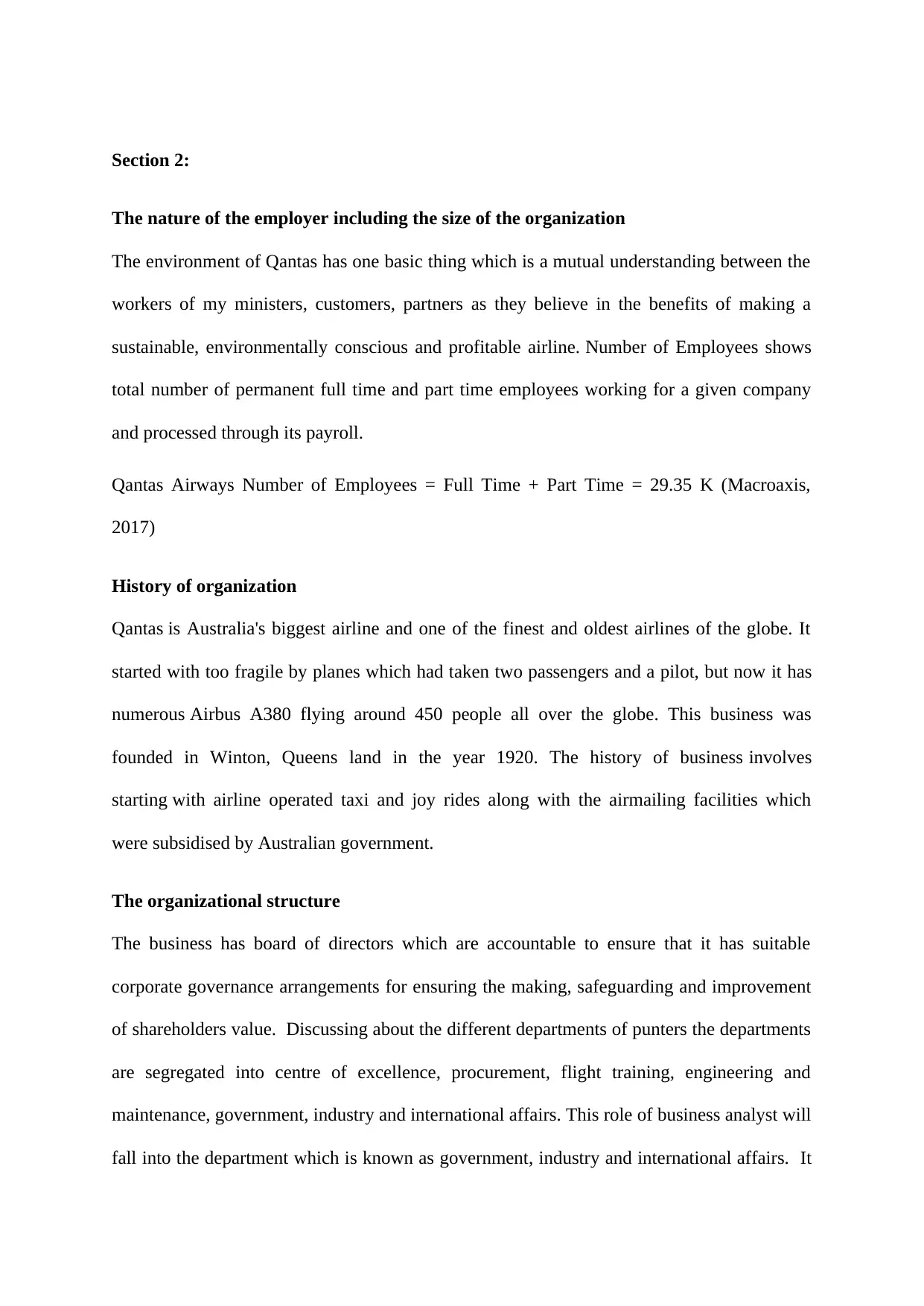
Section 2:
The nature of the employer including the size of the organization
The environment of Qantas has one basic thing which is a mutual understanding between the
workers of my ministers, customers, partners as they believe in the benefits of making a
sustainable, environmentally conscious and profitable airline. Number of Employees shows
total number of permanent full time and part time employees working for a given company
and processed through its payroll.
Qantas Airways Number of Employees = Full Time + Part Time = 29.35 K (Macroaxis,
2017)
History of organization
Qantas is Australia's biggest airline and one of the finest and oldest airlines of the globe. It
started with too fragile by planes which had taken two passengers and a pilot, but now it has
numerous Airbus A380 flying around 450 people all over the globe. This business was
founded in Winton, Queens land in the year 1920. The history of business involves
starting with airline operated taxi and joy rides along with the airmailing facilities which
were subsidised by Australian government.
The organizational structure
The business has board of directors which are accountable to ensure that it has suitable
corporate governance arrangements for ensuring the making, safeguarding and improvement
of shareholders value. Discussing about the different departments of punters the departments
are segregated into centre of excellence, procurement, flight training, engineering and
maintenance, government, industry and international affairs. This role of business analyst will
fall into the department which is known as government, industry and international affairs. It
The nature of the employer including the size of the organization
The environment of Qantas has one basic thing which is a mutual understanding between the
workers of my ministers, customers, partners as they believe in the benefits of making a
sustainable, environmentally conscious and profitable airline. Number of Employees shows
total number of permanent full time and part time employees working for a given company
and processed through its payroll.
Qantas Airways Number of Employees = Full Time + Part Time = 29.35 K (Macroaxis,
2017)
History of organization
Qantas is Australia's biggest airline and one of the finest and oldest airlines of the globe. It
started with too fragile by planes which had taken two passengers and a pilot, but now it has
numerous Airbus A380 flying around 450 people all over the globe. This business was
founded in Winton, Queens land in the year 1920. The history of business involves
starting with airline operated taxi and joy rides along with the airmailing facilities which
were subsidised by Australian government.
The organizational structure
The business has board of directors which are accountable to ensure that it has suitable
corporate governance arrangements for ensuring the making, safeguarding and improvement
of shareholders value. Discussing about the different departments of punters the departments
are segregated into centre of excellence, procurement, flight training, engineering and
maintenance, government, industry and international affairs. This role of business analyst will
fall into the department which is known as government, industry and international affairs. It

is important that as a national carrier, Qantas group stays committed to support the Australian
jobs and operations and maintains its position as one of the major supporters of economic
activities of Australia.
Culture and/or mission
As per the Quanta’s annual reports, its strong vision is in terms of both the Jetstar airline and
Qantas. This vision is to be the world’s best premium airline and the world’s best low fare
carrier.
For achieving these visions, the culture is very important aspect in Qantas and there are five
key strategist defined in the business. The strategies involved – keeping safety as the initial
priority, choosing the right aircraft and right routes, focusing at customer service excellence,
focusing that operational efficiencies and the understanding of both these brands Qantas and
Jetstar for supporting the business to be ahead of other businesses in terms of domestic and
international airways.
Branches or subsidiaries
Along with the key businesses of transporting people and airfreight, Qantas is operational in
lots of subsidiaries which Jet Star, Qantas link and has been in walled in linked firms such as
holidaying, in flight catering and travel businesses. Qantas link has been operational for more
than 2000 flights every week to 56 Metropolitan cities, international and local destinations all
over Australia and towards Port Moresby in Papua New Guinea.
Clients or customers
Businesses have to communicate with a collection of diverse customers. Qantas, for instance,
interrelates with customers like individuals and household customers, commercial clients to
government clientele. Everyone has to be targeted in a different way by Qantas. The
individual/ household consumers look for value for cash and are continually looking for a
jobs and operations and maintains its position as one of the major supporters of economic
activities of Australia.
Culture and/or mission
As per the Quanta’s annual reports, its strong vision is in terms of both the Jetstar airline and
Qantas. This vision is to be the world’s best premium airline and the world’s best low fare
carrier.
For achieving these visions, the culture is very important aspect in Qantas and there are five
key strategist defined in the business. The strategies involved – keeping safety as the initial
priority, choosing the right aircraft and right routes, focusing at customer service excellence,
focusing that operational efficiencies and the understanding of both these brands Qantas and
Jetstar for supporting the business to be ahead of other businesses in terms of domestic and
international airways.
Branches or subsidiaries
Along with the key businesses of transporting people and airfreight, Qantas is operational in
lots of subsidiaries which Jet Star, Qantas link and has been in walled in linked firms such as
holidaying, in flight catering and travel businesses. Qantas link has been operational for more
than 2000 flights every week to 56 Metropolitan cities, international and local destinations all
over Australia and towards Port Moresby in Papua New Guinea.
Clients or customers
Businesses have to communicate with a collection of diverse customers. Qantas, for instance,
interrelates with customers like individuals and household customers, commercial clients to
government clientele. Everyone has to be targeted in a different way by Qantas. The
individual/ household consumers look for value for cash and are continually looking for a
⊘ This is a preview!⊘
Do you want full access?
Subscribe today to unlock all pages.

Trusted by 1+ million students worldwide
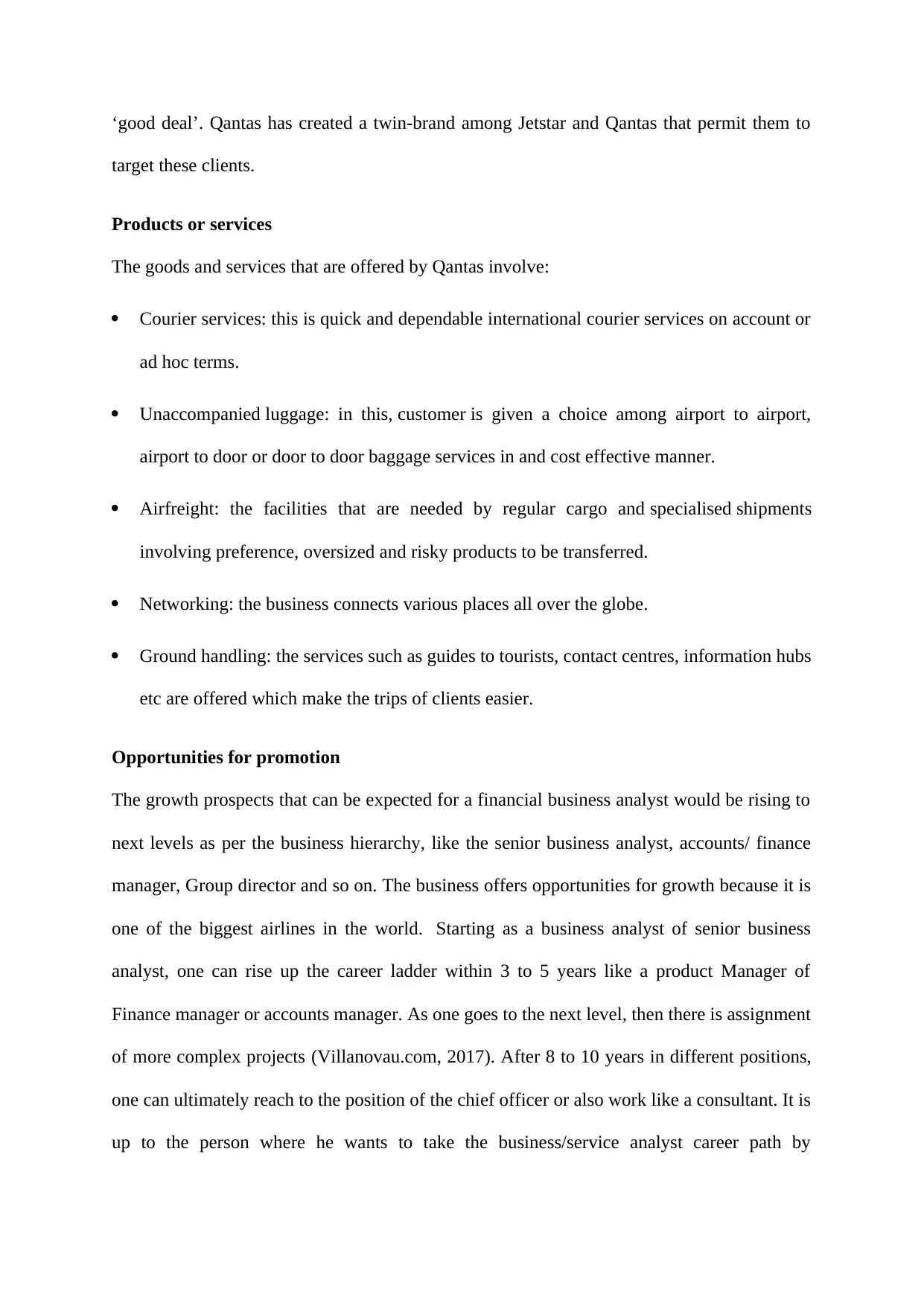
‘good deal’. Qantas has created a twin-brand among Jetstar and Qantas that permit them to
target these clients.
Products or services
The goods and services that are offered by Qantas involve:
Courier services: this is quick and dependable international courier services on account or
ad hoc terms.
Unaccompanied luggage: in this, customer is given a choice among airport to airport,
airport to door or door to door baggage services in and cost effective manner.
Airfreight: the facilities that are needed by regular cargo and specialised shipments
involving preference, oversized and risky products to be transferred.
Networking: the business connects various places all over the globe.
Ground handling: the services such as guides to tourists, contact centres, information hubs
etc are offered which make the trips of clients easier.
Opportunities for promotion
The growth prospects that can be expected for a financial business analyst would be rising to
next levels as per the business hierarchy, like the senior business analyst, accounts/ finance
manager, Group director and so on. The business offers opportunities for growth because it is
one of the biggest airlines in the world. Starting as a business analyst of senior business
analyst, one can rise up the career ladder within 3 to 5 years like a product Manager of
Finance manager or accounts manager. As one goes to the next level, then there is assignment
of more complex projects (Villanovau.com, 2017). After 8 to 10 years in different positions,
one can ultimately reach to the position of the chief officer or also work like a consultant. It is
up to the person where he wants to take the business/service analyst career path by
target these clients.
Products or services
The goods and services that are offered by Qantas involve:
Courier services: this is quick and dependable international courier services on account or
ad hoc terms.
Unaccompanied luggage: in this, customer is given a choice among airport to airport,
airport to door or door to door baggage services in and cost effective manner.
Airfreight: the facilities that are needed by regular cargo and specialised shipments
involving preference, oversized and risky products to be transferred.
Networking: the business connects various places all over the globe.
Ground handling: the services such as guides to tourists, contact centres, information hubs
etc are offered which make the trips of clients easier.
Opportunities for promotion
The growth prospects that can be expected for a financial business analyst would be rising to
next levels as per the business hierarchy, like the senior business analyst, accounts/ finance
manager, Group director and so on. The business offers opportunities for growth because it is
one of the biggest airlines in the world. Starting as a business analyst of senior business
analyst, one can rise up the career ladder within 3 to 5 years like a product Manager of
Finance manager or accounts manager. As one goes to the next level, then there is assignment
of more complex projects (Villanovau.com, 2017). After 8 to 10 years in different positions,
one can ultimately reach to the position of the chief officer or also work like a consultant. It is
up to the person where he wants to take the business/service analyst career path by
Paraphrase This Document
Need a fresh take? Get an instant paraphrase of this document with our AI Paraphraser

management levels depending on the experience, talent and desires of the individual.
Dependent on the kind of career path chosen by one, it is expected that there would be high
rewards and lucrative career.
Dependent on the kind of career path chosen by one, it is expected that there would be high
rewards and lucrative career.

Section 3:
Typical career path one follows as you advance in this career.
With higher experience and know-how, a senior financial analyst can carry on into a
supervisory role. A senior analyst in the aviation industry usually moves up to becoming a
treasury manager or the accounts manager for the business, managing a team of senior
analysts. There might also be a chance to get into a senior management position. In the
corporate world, senior analysts can turn out to be treasury managers who supervise the
operational groups within their divisions. A great performer might go up to different ranks to
turn out to be a chief financial officer (CFO) accountable for the entire of the firm’s financial
performance.
What is an entry-level position?
The entry level position is of the Business analyst (Finance), which can be sought by a
graduate. A fresh bachelor's degree graduate who looks forward to be a financial analyst can
anticipate starting with a junior role in the direction of a senior analyst. Subsequent to many
years of practice, lots of junior financial analysts think about going back to graduate school
for higher degrees. Despite the fact that junior analysts are not disqualified from
development, regular development to positions with superior accountability generally
requires going back to school. A graduate who also will possess a master's degree can
anticipate starting the job as a senior financial analyst or going up to the role extremely quick.
What are other names of entry-level positions?
The other names for the entry-level roles are junior analysts, financial assurance analyst,
junior accountant, finance executive, accounts executive etc.
Typical career path one follows as you advance in this career.
With higher experience and know-how, a senior financial analyst can carry on into a
supervisory role. A senior analyst in the aviation industry usually moves up to becoming a
treasury manager or the accounts manager for the business, managing a team of senior
analysts. There might also be a chance to get into a senior management position. In the
corporate world, senior analysts can turn out to be treasury managers who supervise the
operational groups within their divisions. A great performer might go up to different ranks to
turn out to be a chief financial officer (CFO) accountable for the entire of the firm’s financial
performance.
What is an entry-level position?
The entry level position is of the Business analyst (Finance), which can be sought by a
graduate. A fresh bachelor's degree graduate who looks forward to be a financial analyst can
anticipate starting with a junior role in the direction of a senior analyst. Subsequent to many
years of practice, lots of junior financial analysts think about going back to graduate school
for higher degrees. Despite the fact that junior analysts are not disqualified from
development, regular development to positions with superior accountability generally
requires going back to school. A graduate who also will possess a master's degree can
anticipate starting the job as a senior financial analyst or going up to the role extremely quick.
What are other names of entry-level positions?
The other names for the entry-level roles are junior analysts, financial assurance analyst,
junior accountant, finance executive, accounts executive etc.
⊘ This is a preview!⊘
Do you want full access?
Subscribe today to unlock all pages.

Trusted by 1+ million students worldwide
1 out of 19
Related Documents
Your All-in-One AI-Powered Toolkit for Academic Success.
+13062052269
info@desklib.com
Available 24*7 on WhatsApp / Email
![[object Object]](/_next/static/media/star-bottom.7253800d.svg)
Unlock your academic potential
Copyright © 2020–2025 A2Z Services. All Rights Reserved. Developed and managed by ZUCOL.




